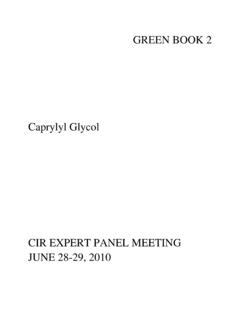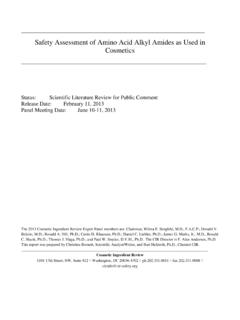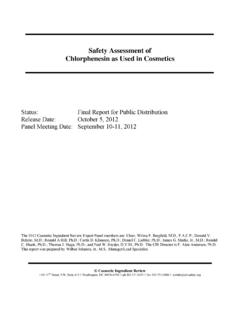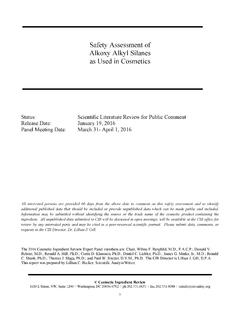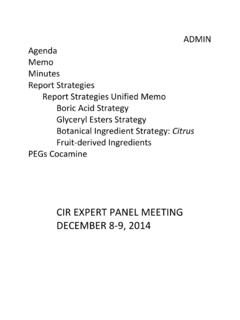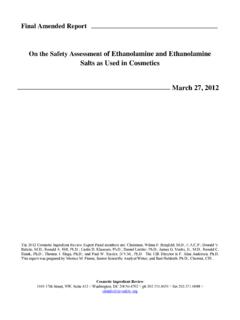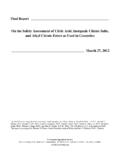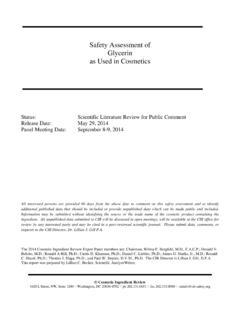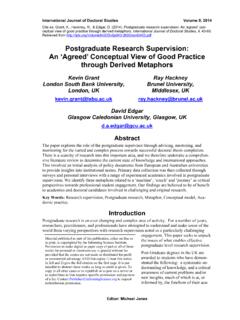Transcription of Cucumis Sativus (Cucumber) -Derived Ingredients as Used …
1 Tentative Safety Assessment Cucumis Sativus ( cucumber ) - derived Ingredients as Used in Cosmetics March 16, 2012 All interested persons are provided 60 days from the above date to comment on this Tentative Safety Assessment and to identify additional published data that should be included or provide unpublished data which can be made public and included. Information may be submitted without identifying the source or the trade name of the cosmetic product containing the ingredient. All unpublished data submitted to CIR will be discussed in open meetings, will be available at the CIR office for review by any interested party and may be cited in a peer-reviewed scientific journal. Please submit data, comments, or requests to the CIR Director, Dr.
2 F. Alan Andersen. The 2012 Cosmetic Ingredient Review Expert Panel members are: Chairman, Wilma F. Bergfeld, , ; Donald V. Belsito, ; Ronald A. Hill, ; Curtis D. Klaassen, ; Daniel Liebler, ; James G. Marks, Jr., , Ronald C. Shank, ; Thomas J. Slaga, ; and Paul W. Snyder, , The CIR Director is F. Alan Andersen, This report was prepared by Monice M. Fiume, Senior Scientific Analyst/Writer. Cosmetic Ingredient Review 1101 17th Street, NW, Suite 412 Washington, DC 20036-4702 ph fax ii TABLE OF CONTENTS Abstract .. 1 Introduction .. 1 Chemistry .. 1 Definition .. 1 Chemical and Physical Properties .. 1 Composition .. 1 Preparation/Extraction .. 2 Use .. 2 Cosmetic .. 2 Toxicokinetics .. 2 Toxicological studies.
3 2 Reproductive and Developmental Toxicity .. 2 Genotoxicity .. 2 Carcinogenicity .. 3 Anti-Tumor Promotion .. 3 Irritation and Sensitization .. 3 Skin Irritation/Sensitization .. 3 Human .. 3 Phototoxicity .. 4 Cross-Allergenicity .. 4 Case Studies .. 4 Ocular Irritation .. 5 In Vitro .. 5 Human .. 5 Summary .. 5 6 Conclusion .. 6 Tables .. 7 Table 1. Definitions, Functions, and Chemical Class .. 7 Table 2. Chemical and Physical Properties .. 7 Table 3. Chemical constituents by plant part .. 7 Table 4. Cucumis Sativus ( cucumber ) lipids, and their fatty acid composition .. 9 Table 5. cucumber seed composition .. 15 Table 6a. Conclusions of CIR safety assessments on Ingredients that are constituents of cucumber .. 16 Table 6b. Toxicity information on some components of cucumber as discussed in previous CIR reports.
4 16 Table 7. Frequency and concentration of use according to duration and type of exposure .. 17 References .. 18 1 ABSTRACT The Expert Panel assessed the safety of six Cucumis Sativus ( cucumber )- derived Ingredients and found them safe in the present practices of use and concentration. These Ingredients are reported to function in cosmetics as skin condi-tioning agents. cucumber is a commonly consumed food and generally recognized as safe. The focus of this assessment was the dermal exposure to the low concentrations of these Ingredients as used in cosmetics. Many of the components of these Cucumis Sativus ( cucumber )- derived cosmetic Ingredients have been previously assessed for safety as cosmetic Ingredients .
5 INTRODUCTION This document is a safety assessment of the following six Cucumis Sativus ( cucumber ) derived Ingredients as used in cosmetic formulations: Cucumis Sativus ( cucumber ) Fruit Extract Cucumis Sativus ( cucumber ) Extract Cucumis Sativus ( cucumber ) Fruit Cucumis Sativus ( cucumber ) Fruit Water Cucumis Sativus ( cucumber ) Juice Cucumis Sativus ( cucumber ) Seed Extract All of the Ingredients included in this safety assessment are reported to function in cosmetics as skin conditioning agents. Cucumis Sativus ( cucumber ) Seed Oil is not included in this safety assessment because it was previously reviewed by the Cosmetic Ingredient Review (CIR) Expert Panel. In 2011, in the Safety Assessment of Plant -Derived Fatty Acid Oils as Used in Cosmetics, it was concluded that Cucumis Sativus ( cucumber ) Seed Oil is safe as used in The chemical composition of cucumber is provided in this safety assessment.
6 Some of the components of cucumber are cosmetic Ingredients for which a CIR safety assessment is available. Others, such as the phytosterols, are compounds that have been discussed in other CIR safety assessments, such as the PEG Soy Sterols Published toxicity data were not readily available. However, according to the Food and Drug Administration (FDA), cucumbers are one of the 20 most frequently consumed raw vegetables ( ). The fact that cucumbers are a commonly consumed food suggests that these Ingredients pose no significant safety issue following oral exposure and argues against the need for oral safety data. Irritation, sensitization, and phototoxicity data were available and are included in this assessment. CHEMISTRY Definition The definition, chemical class, and reported functions of these Ingredients are provided in Table 1.
7 Chemical and Physical Properties Chemical and physical properties are listed in Table 2. Composition cucumber fruit is composed mostly of water; more than 96% of edible unpeeled fruit is Other constituents of Cucum-is Sativus L, according to one source, are vitamins, minerals, amino acids, phytosterols, phenolic acids, fatty acids, and According to another source, traces of essential oil, amino acids, pectins, starch, sugars, vitamin C, and curcurbita-cin are found in Glycosides, steroids, flavonoids, carbohydrates, terpenoids, and tannins were identified in an aqueous extract of the cucumber A comprehensive list of chemical constituents by plant part is presented in Table 3. Liquid chromatography mass spectrometry that incorporated 13C3-labelled standards determined that cucumber contained 12-13 g phytoestrogens/100 g wet wt In the breakdown of the phytoestrogen composition, the content was primari-ly the lignan secoisolariciresinol; the lignan matairesinol, the isoflavones daidzein, genistein, glycitein, biochanin A, and for-mononetin, and coumestrol, comprised <1 g/100 g wet wt of the fruit.
8 Another source reports the following phytosterols in cucumber fruit: 3800 g -sitosterol/100 g edible portion, 200 g campesterol/100 g edible portion, 2900 g stigmasterol/100 g edible portion, 300 g -sitostanol/ 100g edible portion, and 100 g campestanol/100 g edible portion, giving a total plant sterol content of 7300 g/100 g edible The lipid fatty acid content of Cucumis Sativus ( cucumber ) has been described. Table 4 provides information on cucumber lipids and their fatty acid composition. The major fatty acids in cucumbers are palmitic acid ( ), linoleic acid ( ), and linolenic acid (40-46%).9,10 The mixed fatty acid and triterpene alcohol composition of Cucumis Sativus seeds is presented in Table 5. For extrapolation purposes, according to the CIR Safety Assessment on Plant -Derived Oils as Used in Cosmetics, the fatty acid composition of Cucumis Sativus ( cucumber ) seed oil is 9-13% palmitic acid, 6-9% stearic acid, 14-20% oleic acid, 60-68% linoleic acid, and <1% linolenic 2 Table 6a provides the conclusions from safety assessments that exist for some of the constituents of cucumber .
9 Table 6b references information on the safety of some components of cucumber that were discussed in previous CIR reports. Preparation/Extraction Cucumis Sativus ( cucumber ) Fruit Extract is reported to be manufactured by extracting cucumber fruit in mixtures of glycer-in and water,11 water and butylene glycol, or water and propylene The fresh fruit is extracted peeled or unpeeled. A cucumber peel powder extract is prepared by a hydro-alcoholic extraction of the macerated fresh fruit; grain alcohol is used as the The extract ratio is approximately 10:1. USE Cosmetic The Cucumis Sativus -Derived Ingredients included in this safety assessment are reported to function in cosmetics as skin con-ditioning Voluntary Cosmetic Registration Program (VCRP) data obtained from the FDA in 2011 indicate that Cucumis Sativus ( cucumber ) Fruit Extract is used in 534 cosmetic formulations, 350 of which are VCRP data indicate that the other Cucumis Sativus derived Ingredients are used in less than 10 cosmetic formulations.
10 A Personal Care Products Council (Council) survey of the maximum reported use concentrations found that the Cucumis Sativus ( cucumber ) Fruit Water had the highest concentration of use, 3% in foundations, and that Cucumis Sativus ( cucumber ) Fruit Extract was used in eye lotions and face and neck products at up to 1%.16 The concentrations used in rinse-off products and products diluted for (bath) use were and , respectively. Frequency and concentration of use data categorized by exposure and duration of use are provided in Table 7. In some cases, reported use was received by the VCRP, but no concentration of use data were reported in the Council survey. For example, Cucumis Sativus ( cucumber ) Juice is reported to be used according to VCRP data, but no concentration of use data were submitted in response to the Council survey.
